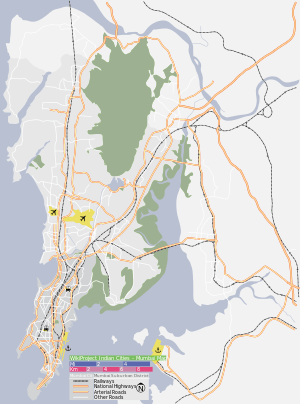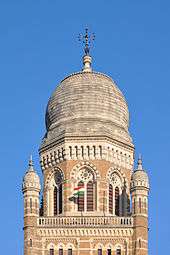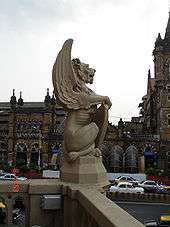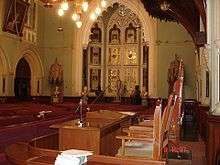Municipal Corporation Building, Mumbai
| Municipal Corporation Building, Mumbai | |
|---|---|
 Bombay Municipal Corporation Building | |
 Location within Mumbai | |
| General information | |
| Architectural style | Gothic Revival style |
| Town or city | Mumbai |
| Country | India |
| Coordinates | 18°56′24″N 72°50′07″E / 18.9400°N 72.8353°E |
| Construction started | 9 December 1884 |
| Completed | 1893 |
| Client | Bombay Presidency |
| Technical details | |
| Structural system | Golden–beige basalt rock exterior |
| Size | 255 ft tower |
| Design and construction | |
| Architect | Frederick William Stevens |
| Engineer | Frederick William Stevens |
The Municipal Corporation Building, Mumbai located in South Mumbai in Maharashtra, India is a Grade IIA heritage building (‘V’ shaped as viewed from top) opposite to the Chhatrapati Shivaji Terminus (an UNESCO World heritage site) at the junction of Dadabhai Naoroji Road and Mahapalika Marg. It is also known as the BrihanMumbai Municipal Corporation Building, or BMC building for short.[1][2]
As the name suggests, the building houses the civic body that governs the city of Mumbai, which is now named the Brihanmumbai Mahanagar Palika (Marathi: बृहन्मुंबई महानगर पालिका) or the Municipal Corporation of Greater Mumbai and which has as its motto, "यतो धर्मस्ततो जय" (Sanskrit: Yato Dharmastato Jaya or, Where there is Righteousness, there shall be Victory), inscribed on the banner of its Coat of Arms.[3][4] It is said to be the largest civic organization in the country and Asia it covers an area of 434 km2 (167.6 sq mi)[5][6]
History


The BMC was created in 1865 and Arthur Crawford was its first Municipal Commissioner. The Municipality was initially housed in a modest building at the terminus of Girgaum Road. In 1870, it was shifted to a building on the Esplanade, located between Watson Hotel and the Sassoon Mechanics Institute where the present Army & Navy building is situated. On December 9, 1884, the foundation stone for the new building of the Bombay Municipal Corporation was laid opposite Victoria Terminus now known as Chhatrapati Shivaji Terminus, by the then Viceroy, Lord Ripon.[7]
Two designs were considered for the building; one of the Gothic designs done by F. W. Stevens and the other in the Indo-Saracenic design presented by Robert Fellowes Chisholm. The Gothic design was finally selected. The building was completed in 1893. The building is known for its 255 ft (77.7 m) tall tower. The chief architectural feature is the central dome that rises to a height of 71.5 m (234.6 ft).[1] The gable has a huge winged allegorical figure representing the 'urbs prima in Indis', the first city of India as it was to be known then. The richly molded and paneled Council Chamber has a ceiling of unpolished teak. Records also support that at these environs Phansi Talao or Gallows Tank, where public hangings took place, was located.[7][8][9] In the period from 1100 to 1500 AD, the architecture of churches constructed with ornamental arches, with ribs supported by buttresses resulted, in the subsequent idea of the framed structural design with grandeur and monumentality during the renaissance period of 1500–1700 AD, as the distinct style; the Bombay Municipal Corporation building, the Victoria Terminus, the Rajabai tower and the University of Bombay are some examples of this style. The old style of dome construction was also revived and became popular; 1750 onwards was considered to be the period of modern architecture.[10] The Gothic architecture with controlled composition custom–made to the climatic extremes of the city has cusped window arches and elaborately domed corner towers.[11]
At the entrance to the BMC stands an impressive bronze statue of Sir Pherozeshah Mehta that gives a picturesque view of the roads and buildings in front (pictured).[6]
Heritage status and restoration



The Mumbai Heritage Conservation Committee of the Municipal Corporation of Mumbai has categorized the heritage buildings of Mumbai under the guidelines prepared for the purpose. According to these guidelines, the Municipal Corporation Building, Bombay has been categorized by the Bombay Municipal Corporation as Grade II A. The list of heritage buildings, as categorized on April 24, 2005, under Grade I, Grade II, Grade IIA, Grade III and Precincts are 591. For the Bombay Municipal Corporation Building, the details are elaborated below.[2][2] [12]
157. Grade-IIA Bombay Municipal Corporation (MCGM Headquarter) - Value Classification - A(his), I(sce), C(seh) A(arch), B(per), B(des), F
Grade-II (A&B) is defined as:[12]
Buildings, of regional or local importance, possessing special architectural or aesthetical merit, cultural or historical value, though of a lower scale than in Heritage Grade. They are local landmarks, contributing to the image and identity of the City.
As per the defined “Scope for Changes (Grade-IIA)”, the restorations permitted are:[12]
Internal changes, and adaptive reuse will be generally allowed, but external changes will be subject to scrutiny Care would be taken to ensure the conservation of all special aspects for which it is included in Heritage Grade-II.
The “Abbreviations of Criteria (Classification)” used for listing of buildings and conservation areas are:[12]
a) Value for architectural, historical or cultural reasons A
- architectural A(arc)
- historical A(his)
- cultural A(cul)
b) The date and / or period and / or design and / or unique use of the buildings or artefact B
- period B(per)
- design B(des)
- use B(uu)
c) Relevance to social or economic history C (seh)
d) Association with well-known persons or events D (bio)
e) A building or groups of buildings and / or areas, of a distinct architectural design and / or style, historic period or way of life having sociological interest and / or community value E
- Style
- Historical
f) The unique value of a building or architectural features or artifact and / or being part of a chain of architectural development that would be broken if it were lost F
g) Its value as a part of a group of buildings G (grp)
h) Representing forms of technological development H (tec)
i) Vistas of natural / scenic beauty or interest, including water–front areas, distinctive and / or planned lines of sight, street line, skyline or topographical I (sce) j) Open spaces sometimes integrally planned with their associated areas having a distinctive way of life and for which are and have the potential to be areas of recreation J

In keeping with the above categorization, the restoration works of the Municipal Corporation Building, Mumbai was planned by a panel of three conservation architects, namely, Abha Narain Lambah, Shashi Prabhu and Shimul Zaveri Kadri. The restoration plan for the 125-year-old BMC Gothic structure envisages a) restoration of interiors and the exterior – from the roof tiles to the exquisite Minton tiles inside and to stained glass work and b) strengthening several wooden beams.[12] In the first phase the structure would be restored to its original glory involving replacement of broken tiles, repair of statues,and removal of plants and moss.[12]
The subsequent phases of restoration would involve a) reorganization of office space within the building to improve the operational efficiency of staff members, b) 'Citizens Facilitation Centre' and party offices in the ground floor and c) Corporation Hall to be modified for a larger seating arrangement by including outer corridors and opening the wooden doors to increase its seating capacity from 200 to 300.[12]
Estimated to cost Rs 80 crore (US$16 million, at current exchange rate), approved by the Mumbai Heritage Conservation Committee and the civic administration, it is the largest and most comprehensive conservation concept undertaken in the city, without disturbing the routine work of the civic affairs and administration of the BMC.[12]
The Municipal Corporation of Greater Mumbai (MCGM), as the primary agency responsible for urban governance, has also signed an MOU with NGO Council to work closely with NGOs in the fields of education, public health, creation of urban amenities, art and culture and heritage conservation.[13]
See also
- Municipal Corporation of Greater Mumbai(MCGM) or Brihanmumbai Municipal Corporation (BMC)
- Coat of arms of Mumbai
- Administrative divisions of Mumbai
- Mayor of Mumbai
- Municipal Commissioner of Mumbai
- Sheriff of Mumbai
References
| Wikimedia Commons has media related to BMC building. |
- 1 2 "The Municipal Corporation Building". Retrieved 2009-03-27.
- 1 2 3 "Heritage Conservation in Mumbai" (PDF). Retrieved 2009-03-27.
- ↑ "the Municipal Corporation of Greater Mumbai". Retrieved 2009-03-27.
- ↑ "Coat of Arms of the City of Mumbai". Retrieved 2009-03-27.
- ↑ "Bombay Municipal Corporation". Archived from the original on 2007-08-12. Retrieved 2009-03-27.
- 1 2 "Landmarks in and around Colaba". Archived from the original on 2011-07-14. Retrieved 2009-03-27.
- 1 2 "The Bombay Municipal Corporation, Bombay c. 1880". Retrieved 2009-03-27.
- ↑ "Mumbaimunicipalcorporationbuilding". Retrieved 2009-03-27.
- ↑ "Mumbai City travel Guide". Retrieved 2009-03-27.
- ↑ M.G.Shah; C M Kale; S Y Patki (2002). Building Drawing with an Integrated approach to Built Environment. Tata Macgraw-hill. ISBN 9780074638767. Retrieved 2009-03-27.
- ↑ "Heritage Buildings". Retrieved 2009-03-27.
- 1 2 3 4 5 6 7 8 Shweta Desai (2008-01-06). "125-year-old BMC building set to regain old glory". Archived from the original on 2012-09-23. Retrieved 2009-03-27.
- ↑ "Memorandum of Understanding Between Municipal Corporation of Greater Mumbai (MCGM) & NGO Council". 2005-12-12. Retrieved 2009-03-27.
